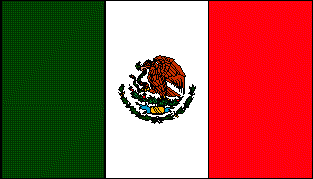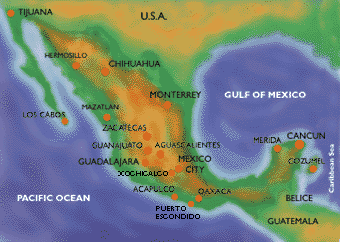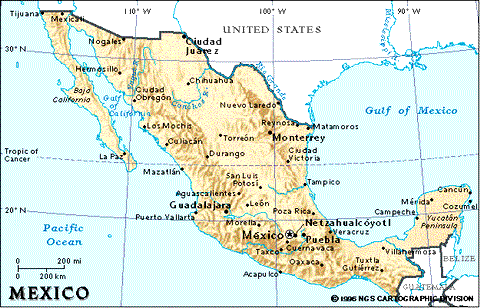So You Want to go to México...
 No matter what language you speak, you'll know that
Mexico is a great and wondrous place to visit. Millions of Americans
discover the charm and hospitality of our Southern neighbors. So you want to go to
Mexico? Well we have created this website in hopes of helping you better prepare for
your journey. The purpose is to allow you, the surfer, to gain a better working
knowledge of the Mexican people, culture, and history. For your convenience, we have
also included a currency convertor to give you a better understanding of the monetary
differences between our two countries as well as other Spanish-speaking countries.
The links page will allow you to explore other sites with similar themes and interests.
Also, at the end of your exploration, please take the time to quiz yourself on your new
knowledge with our Pop Quiz. This will allow you to see how much you've learned
about the foreign culture. The following is a brief summary of Mexico, as provided
by the National Geographic World Atlas, which also includes some vital statistics
about Los Estados Unidos de México. We hope you find this as well as the other
pages useful in your journey abroad.
No matter what language you speak, you'll know that
Mexico is a great and wondrous place to visit. Millions of Americans
discover the charm and hospitality of our Southern neighbors. So you want to go to
Mexico? Well we have created this website in hopes of helping you better prepare for
your journey. The purpose is to allow you, the surfer, to gain a better working
knowledge of the Mexican people, culture, and history. For your convenience, we have
also included a currency convertor to give you a better understanding of the monetary
differences between our two countries as well as other Spanish-speaking countries.
The links page will allow you to explore other sites with similar themes and interests.
Also, at the end of your exploration, please take the time to quiz yourself on your new
knowledge with our Pop Quiz. This will allow you to see how much you've learned
about the foreign culture. The following is a brief summary of Mexico, as provided
by the National Geographic World Atlas, which also includes some vital statistics
about Los Estados Unidos de México. We hope you find this as well as the other
pages useful in your journey abroad.
A 3,115-kilometer (1,936-mile) common border, commerce, and tourism link the
world's largest Spanish-speaking country to the world's largest economic power.
Mexico sends half its oil exports, drawn from reserves ranked eighth worldwide, to its
northern neighbor. The U.S. returns manufactured goods and foodstuffs. Agriculture,
limited by rugged topography and uneven rainfall, remains an important employer,
although price controls have reduced farm earnings and wage controls have lowered the
standard of living. The nation's system of communal farms, or ejidos, was reformed
in 1992 to promote private investment and large-scale agriculture. Farmers grow 20
percent of U.S. winter vegetables.
The nation is blessed with abundant minerals- notably silver, copper, sulfur, lead, and zinc-advanced technology,  and a huge workforce. It profits from a thriving
maquiladora industry along the border. Products are assembled by inexpensive labor at
mostly U.S.-owned plants, then exported back to the U.S. and elsewhere.
and a huge workforce. It profits from a thriving
maquiladora industry along the border. Products are assembled by inexpensive labor at
mostly U.S.-owned plants, then exported back to the U.S. and elsewhere.
Tax reform, privatization of state-run industries, more open trade policies,
drastic austerity measures, and restructuring the hundred-billion-dollar foreign debt
began to improve competitiveness and boost exports in the early 1990s. To create new jobs and further spur the economy, a free-trade agreement with Canada and the U.S. was implemented in 1994. In spite of the promise of future economic gains,
overspending and reckless lending practices helped precipitate a Mexican banking and credit crisis in 1995.
With more than 15 million people, many living in barrio slums, Greater Mexico City is one of  the world's largest metropolitan areas. Tough environmental restrictions have been enacted to cope with increasingly dangerous levels of air and water pollution. In 1985 the city was hard hit by an earthquake that left 9,000 dead and 95,000 homeless.
the world's largest metropolitan areas. Tough environmental restrictions have been enacted to cope with increasingly dangerous levels of air and water pollution. In 1985 the city was hard hit by an earthquake that left 9,000 dead and 95,000 homeless.
Mexico's declining birthrate promises some relief from the crushing pressure of its population, expected to exceed a hundred million by the year 2000. One-third of all Mexicans are younger than 15. The flood of illegal immigrants-and drugs-across the border taxes relations with the U.S. During the 1980s Mexicans seeking work made more than 20 million illegal border crossings.
Tourism, along with petroleum revenues, is a leading earner of foreign exchange. About 90 percent of the more than six million visitors come from the U.S. and Canada. On the Yucatán Peninsula and elsewhere, restoration of ancient temple-pyramids and city complexes brings to light the sophistication of the Maya and Aztec civilizations.
MEXICO Vital Statistics
AREA: 1,958,201 sq km (756,066 sq mi).
POPULATION: 93,674,000.
CAPITAL: Mexico City, pop. 9,815,800 (15,643,000).
RELIGION: Roman Catholic.
LANGUAGE: Spanish, Indian languages.
LITERACY: 90%.
LIFE EXPECTANCY: 72 years.
PRESIDENT (1998): Ernesto Zedillo
ECONOMY: Industry: petroleum, food processing, mining, textiles, motor
vehicles, chemicals. Export crops: coffee, cotton, fruits,
vegetables. Food crops: corn, wheat, rice, beans.
PCI: US$3,750.

Click on a major city in the Map of Mexico and it will take you to more information on that city. This map was taken from the National Geographic MapMaker site.
 No matter what language you speak, you'll know that
Mexico is a great and wondrous place to visit. Millions of Americans
discover the charm and hospitality of our Southern neighbors. So you want to go to
Mexico? Well we have created this website in hopes of helping you better prepare for
your journey. The purpose is to allow you, the surfer, to gain a better working
knowledge of the Mexican people, culture, and history. For your convenience, we have
also included a currency convertor to give you a better understanding of the monetary
differences between our two countries as well as other Spanish-speaking countries.
The links page will allow you to explore other sites with similar themes and interests.
Also, at the end of your exploration, please take the time to quiz yourself on your new
knowledge with our Pop Quiz. This will allow you to see how much you've learned
about the foreign culture. The following is a brief summary of Mexico, as provided
by the National Geographic World Atlas, which also includes some vital statistics
about Los Estados Unidos de México. We hope you find this as well as the other
pages useful in your journey abroad.
No matter what language you speak, you'll know that
Mexico is a great and wondrous place to visit. Millions of Americans
discover the charm and hospitality of our Southern neighbors. So you want to go to
Mexico? Well we have created this website in hopes of helping you better prepare for
your journey. The purpose is to allow you, the surfer, to gain a better working
knowledge of the Mexican people, culture, and history. For your convenience, we have
also included a currency convertor to give you a better understanding of the monetary
differences between our two countries as well as other Spanish-speaking countries.
The links page will allow you to explore other sites with similar themes and interests.
Also, at the end of your exploration, please take the time to quiz yourself on your new
knowledge with our Pop Quiz. This will allow you to see how much you've learned
about the foreign culture. The following is a brief summary of Mexico, as provided
by the National Geographic World Atlas, which also includes some vital statistics
about Los Estados Unidos de México. We hope you find this as well as the other
pages useful in your journey abroad.
 the world's largest metropolitan areas. Tough environmental restrictions have been enacted to cope with increasingly dangerous levels of air and water pollution. In 1985 the city was hard hit by an earthquake that left 9,000 dead and 95,000 homeless.
the world's largest metropolitan areas. Tough environmental restrictions have been enacted to cope with increasingly dangerous levels of air and water pollution. In 1985 the city was hard hit by an earthquake that left 9,000 dead and 95,000 homeless.
